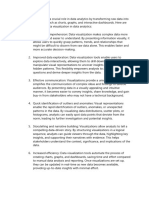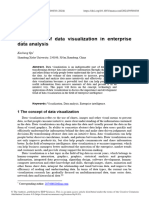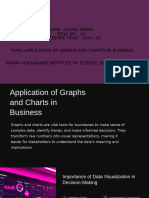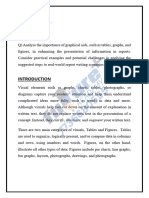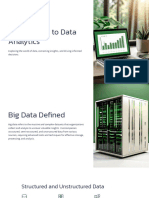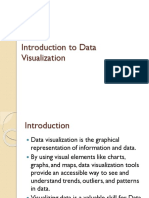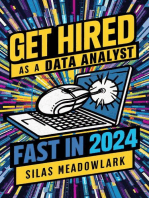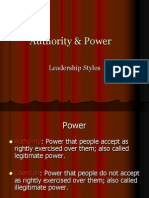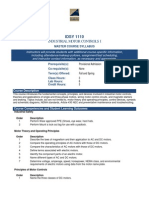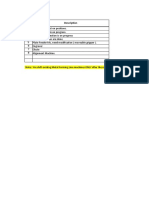Mahesh Paper
Mahesh Paper
Uploaded by
vamsi.d124Copyright:
Available Formats
Mahesh Paper
Mahesh Paper
Uploaded by
vamsi.d124Original Title
Copyright
Available Formats
Share this document
Did you find this document useful?
Is this content inappropriate?
Copyright:
Available Formats
Mahesh Paper
Mahesh Paper
Uploaded by
vamsi.d124Copyright:
Available Formats
Enhancing Data Understanding and Decision Making Through Effective Use of
Charts and Graphs
S.Mahesh Babu1 K.Chandrasekhar2
th
Reg No:2722149,4 semester of MCA, Mother Theresa Institute of Computer Application, Palamaner.
S.V. University, Tirupati, Andhra Pradesh, India.
mmaheshbabu403@gmail.com
Associate Professor, Dept. of. MCA, Mother Theresa Institute of Computer Application, Palamaner.
S.V. University, Tirupati, Andhra Pradesh, India.
chandrasekhar.plr@gmail.com
Abstract:
In today's data-driven world, the capacity to comprehend and infer bits of knowledge from complex datasets is vital for educated decision-
making over different spaces. Charts and charts serve as capable apparatuses for visualizing information, empowering people to get a handle
on designs, patterns, and connections more naturally. This paper investigates the centrality of utilizing charts and charts viably to improve
information understanding and decision-making forms. The primary area talks about the basic part of visualization in disentangling complex
datasets and encouraging comprehension. It emphasizes the significance of selecting suitable chart sorts based on the nature of the information
and the aiming message. By showing data outwardly, charts and charts not as it were help in recognizing de-signs but also offer assistance in
communicating experiences successfully to assorted groups of onlookers. Following, the paper investigates different sorts of charts and charts
commonly utilized in information examination, such as bar charts, line charts, pie charts, scramble plots, and histograms. Each sort is gone
with by cases outlining its reasonableness for distinctive scenarios and information representations. Furthermore, it highlights best hones for
planning outwardly engaging and instructive charts, counting legitimate labeling, scaling, and color choices. Besides, the paper talks about
how vi-able visualization strategies can encourage superior choice making different areas, including trade, back, healthcare, and the scholarly
community. By changing crude information into visual representations, choice producers can rapidly distinguish exceptions, patterns, and
relationships, driving to more educated and opportune choices. In conclusion, the paper addresses potential challenges and restrictions related
to information visualization, such as errors in charts, information mutilation, and the chance of distortion .
Keywords:
Information visualization, Charts, Charts, Information investigation, Choice making, Visual communication, Information visualization,
Information elucidation, Insights, Visualization methods, choice making, Information comprehension, Information representation, Data
design, Visual analytic.
1.Introduction: knowledge. Eventually, this paper highlights the transformative
control of charts and charts in opening the total potential of
In today's data-driven world, organizations are immersed with information. By tackling the visual representation of information,
endless sums of information from different sources. The capacity to organizations can pick up a more profound understanding of their
viably analyze and decipher this information is vital for making operations, recognize openings, moderate dangers, and make
educated choices and picking up a competitive edge. Be that as it may, educated choices that drive victory.
crude information alone can be overpowering and troublesome to
comprehend. Usually where visualizations such as charts and charts 2.Content:
play an essential role. Charts and charts give a visual representation
of information, making complex data more open and reasonable. By In this paper, we investigate the significance of successful
changing numbers into visual designs and patterns, they encourage information visualization utilizing charts and charts to upgrade
speedier comprehension and more profound bits of knowledge. information understanding and decision-making forms. We examine
Whether it's recognizing patterns, spotting peculiarities, or different sorts of visualizations, their preferences, and when to utilize
communicating discoveries to partners, charts, and charts serve as them fittingly. Moreover, we dive into best hones for making
capable tools within the decision-making process. In this paper, we'll impactful visualizations and common pitfalls to maintain a strategic
dig into the significance of compelling data visualization through distance from. Real-world cases over diverse businesses illustrate the
charts and charts and how it contributes to improving information transformative control of charts and charts in opening the total
understanding and decision-making forms. We are going investigate potential of information.
different sorts of charts and charts, their particular points of interest, Presentation
and when to use them suitably. Moreover, we are going examine the
best hones to make impactful visualizations and common pitfalls to 1.A brief outline of the significance of information
maintain a strategic distance from.Besides, we are going to look at visualizationPresentation of the part of charts and charts in upgrading
real-world illustrations where the utilization of charts and charts has information understanding and decision-making
driven noteworthy changes in decision-making over diverse
2.Diagram of the paper structure
businesses. From back to healthcare, showcasing to instruction,
the application of visualizations has revolutionized how . Significance of Information Visualization
organizations analyze information and determine noteworthy bits of
Why information visualization things Cognitive benefits of
visualizing information Challenges of understanding crude
information
3. Sorts of Charts and Charts Presentation to different sorts of
visualizations (e.g., bar charts, line charts, pie charts, scramble
plots)Preferences and restrictions of each sort When to utilize diverse
sorts of charts and charts based on information characteristics and
targets
4. Best Hones for Successful Information Visualization Choosing the
proper visualization for the information plan standards for making 3.3 Charts and
clear and natural visualizations Utilizing color, measure, and other Graphs for Data Visualization
visual components successfully Joining interactivity for more
profound in-ves-litigation
5. Common Pitfalls to Maintaining a strategic distance from
Overloading visualizations with superfluous subtle elements
Deceiving representations of information Falling flat to consider the
audience's viewpoint Disregarding openness contemplations 4.Results and Discussions:
In this area, we are going dig into what comes about through the
compelling utilization of charts and charts for enhancing data
understanding and decision-making forms. We are going examine the
effect of visualizations on different perspectives of decision-making,
drawing bits of knowledge from real-world cases and case thinks
3.Graphs: about.
1. Made strides in Information Understanding:
Visual representations such as charts and charts give a clearer
understanding of complex information sets by highlighting designs,
patterns, and connections. By visualizing information, partners can
rapidly get a handle on key experiences without the requirement for
broad information investigation, driving more educated decision-
making.
2. Upgraded Communication: Visualizations serve as effective
communication apparatuses, empowering partners to communicate
complex data briefly and justifiably. Charts and charts encourage
communication over different groups of onlookers, counting non-
technical partners, by displaying information in an outwardly
3.1Data Visualization’s Positive Impact on Decision Making engaging organization.
3. Distinguishing proof of Patterns and Designs: Visualizations
empower the recognizable proof of patterns, designs, and exceptions
in information sets, permitting organizations to create proactive
choices based on rising experiences. By visualizing chronicled
information patterns, organizations can anticipate future
improvements and alter their procedures in like manner.
4. Encouraged Decision-Making:
Visualizations help decision-making by giving partners actionable
insights determined from information investigation. Decision-makers
can utilize visualizations to compare distinctive scenarios, assess
3.2Charts and choices, and evaluate the potential effect of their choices.
Graphs Effectively 5. Real-World Cases: Within the fund industry, visualizations such as
line charts and candlestick charts are utilized to analyze stock
showcase patterns and advise venture choices. Healthcare
organizations use visualizations to track quiet results, screen malady
flare-ups, and optimize asset assignment. Showcasing groups utilize
charts and charts to analyze customer data, distinguish target
socioeconomics, and determine the viability of promoting [10]. Cleveland, W. S., & McGill, R. (1985).
campaigns. GraphicalDiscernment:Hypothesis, Experimentation, and
Application to the Improvement of Graphical Strategies. Diary of the
Instructive education utilizes visualizations to track understudy American Factual Affiliation, 79(387), 531-554.
execution, recognize ranges for enhancement, and personalize
learning encounters. Authors Profile
S.Mahesh Babu Perusing Master’s Degree in Mother Theresa
Institute of Computer Applications,Palamaner, Affiliated to S.V
University, Tirupati. His areas of Interests Are Data Science.
5.Conclusion: Mr. K. ChandraSekhar working as Associate
Professor in Mother Theresa Institute of Computer
In conclusion, the viable utilization of charts and charts plays a Applications, Palamaner Affiliated and
pivotal part in improving information understanding and decision-
Research Scholar to S.V. University, Tirupati. He
making forms over different businesses. Through this paper, we have has 20 years of experience in IT and Education
investigated the significance of information visualization and the Sector. His areas of Interests are Computer
transformative effect it has on opening the complete potential of Networks, Data Mining, Operating System,
information. By leveraging visual representations such as charts and Cryptography.
charts, organizations can accomplish a few key benefits. Firstly,
visualizations give a clearer understanding of complex information
sets by highlighting designs, patterns, and connections. This
enhanced data understanding empowers partners to form more
educated choices and take proactive actions based on significant
experiences determined from the visual investigation. Furthermore,
visualizations serve as effective communication instruments,
empowering partners to communicate complex data briefly and
reasonably. Whether communicating with specialized specialists or
non-technical gatherings of people, charts, and charts encourage
viable communication by showing information in an outwardly
engaging organization. Additionally, visualizations help decision-
making by encouraging the distinguishing proof of patterns, designs,
and exceptions in information sets. Decision-makers can utilize
visualizations to compare distinctive scenarios, evaluate options, and
survey the potential effects of their choices. This empowers
organizations to form data-driven choices that are adjusted to their
vital destinations and objectives.
6.References:
[1] Few, S., & Harrower, M. (2014). Information Visualization for
Human Recognition. Union Lectures on Visualization, 1-110.
[2]. Tufte, E. R. (2001). The Visual Show of Quantitative Data.
Design Press.
[3] Cairo, A. (2016). The Honest Craftsmanship: Information, Charts,
and Maps for Communication. Unused Riders.
[4]. Heer, J., & Agrawala, M. (2006). Program Plan Designs for Data
Visualization. IEEE Exchanges on Visualization and Computer
Illustrations, 12(5), 853-860.
[5]. Murray, S. (2013). Intuitive Information Visualization for the
Internet. O'Reilly Media.
[6]. Kosara, R., & Mackinlay, J. (2013). Story-telling: The Another
Step for Visualization. IEEE Computer Illustrations and Applications,
33(5), 44-50.
[7]. Yau, N. (2011). Visualize This:
The Flow-ingData Direct to Plan, Visualization, and Insights. Wiley.
[8]. Wilkinson, L. (2005). The Linguistic Use of Design. Springer
Science & Trade Media.
You might also like
- Ebook Data Visualization EN PDFDocument37 pagesEbook Data Visualization EN PDFempreomar100% (3)
- Walter Kaufman - Goethe, Kant and HegelDocument310 pagesWalter Kaufman - Goethe, Kant and HegelDaniel Correa100% (5)
- Design Report Cover Sheet: Bear River TrussDocument29 pagesDesign Report Cover Sheet: Bear River TrussMaitrabarun KarjeeNo ratings yet
- MaheshDocument3 pagesMaheshvamsi.d124No ratings yet
- Mahesh PaperDocument3 pagesMahesh Papervamsi.d124No ratings yet
- Mahesh1Document3 pagesMahesh1vamsi.d124No ratings yet
- Introduction To Data VisualizationDocument8 pagesIntroduction To Data VisualizationAbinash KumarNo ratings yet
- Fraud Detection in Financial TransactionDocument2 pagesFraud Detection in Financial TransactionramyakreenNo ratings yet
- Power of VisualizationDocument2 pagesPower of VisualizationGOURAV GHOSHNo ratings yet
- Application of Data Visualization in Enterprise DaDocument5 pagesApplication of Data Visualization in Enterprise DaFarhana Zainol AbidinNo ratings yet
- Data VisualizationDocument7 pagesData VisualizationMalik SahabNo ratings yet
- Impact of Data Visualization On Management DecisionsDocument12 pagesImpact of Data Visualization On Management DecisionsDouglas GodoyNo ratings yet
- Mb105 Ayush SinghDocument7 pagesMb105 Ayush Singhprasadsoumik97No ratings yet
- ARTICLE 3 Graphical VisualizationDocument2 pagesARTICLE 3 Graphical Visualizationjlancheta19No ratings yet
- SummariesDocument20 pagesSummariesFizza ShahidNo ratings yet
- Unit III Business AnalyticsDocument8 pagesUnit III Business AnalyticsKushagra krNo ratings yet
- Data Visualization Techniques Traditional Data To Big DataDocument23 pagesData Visualization Techniques Traditional Data To Big DataaghnetNo ratings yet
- 3rd Unit - DADocument20 pages3rd Unit - DAAshwinNo ratings yet
- 1 Design PrinciplesDocument26 pages1 Design PrinciplesnoureldinfatmaNo ratings yet
- Business AnalyticsDocument21 pagesBusiness AnalyticsNespinNo ratings yet
- Reading and Writing Set 2 AssgnDocument16 pagesReading and Writing Set 2 AssgnmuheedpanoliNo ratings yet
- Notes_Data_Analysis_and_Visualization_using_Tableau_complete_notesDocument101 pagesNotes_Data_Analysis_and_Visualization_using_Tableau_complete_notesmahima.m1359No ratings yet
- Data Visualization For S-Math001Document20 pagesData Visualization For S-Math001kat rinaNo ratings yet
- Introduction To Data VisualizationDocument10 pagesIntroduction To Data VisualizationfnxkalpeshNo ratings yet
- Linked-Data-Visualization-in-the-Semantic-WebDocument10 pagesLinked-Data-Visualization-in-the-Semantic-WebSana M.saffarNo ratings yet
- 1 Dataset 101 Visualizations GuidebookDocument122 pages1 Dataset 101 Visualizations GuidebookSzeghalmi AttilaNo ratings yet
- JPNR - S07 - 631Document7 pagesJPNR - S07 - 631testinhoNo ratings yet
- Data Visualization1Document5 pagesData Visualization1JelinNo ratings yet
- Data VisualizationDocument103 pagesData Visualizationrohitmahivijay45No ratings yet
- VivaDocument2 pagesVivacc7579No ratings yet
- 9.P.Milev_.docxDocument6 pages9.P.Milev_.docxgomoramir69No ratings yet
- Assignment-1 - MDS - 114 - Sandeep SinghDocument19 pagesAssignment-1 - MDS - 114 - Sandeep SinghSandeep SinghNo ratings yet
- BDA Lab5Document4 pagesBDA Lab5Saleh ZulNo ratings yet
- Irjet V10i993Document7 pagesIrjet V10i993gs24csr1p40No ratings yet
- UNIT 1 DVTDocument22 pagesUNIT 1 DVTYashwanthNo ratings yet
- Business Statistical Analysis With Software Application: Activity 2Document3 pagesBusiness Statistical Analysis With Software Application: Activity 2AJ GumbanNo ratings yet
- LM3Document9 pagesLM3jashwanthkumar.ad21No ratings yet
- The Role of Data Visualization in Storytelling With DataDocument6 pagesThe Role of Data Visualization in Storytelling With DataSoumodeep Kundu NaneeNo ratings yet
- NBE Key - Unit 2 - Data LiteracyDocument5 pagesNBE Key - Unit 2 - Data Literacyarmanw2010786No ratings yet
- Bi Tools - Comparative StudyDocument14 pagesBi Tools - Comparative StudyAkhil ShrivastavNo ratings yet
- Data VisualizationDocument38 pagesData Visualizationpaulageorgia.bancaso001No ratings yet
- Predictive Analysis For Diabetes Using Tableau: Dhanamma Jagli Siddhanth KotianDocument3 pagesPredictive Analysis For Diabetes Using Tableau: Dhanamma Jagli Siddhanth Kotianrahul sharmaNo ratings yet
- Data Visualization Principles: Dmpa-Sc Access Collaborative Mle ToolkitDocument12 pagesData Visualization Principles: Dmpa-Sc Access Collaborative Mle Toolkitblack90100% (3)
- Visualizing Information Graphics: How To Design Effective Charts and GraphsDocument25 pagesVisualizing Information Graphics: How To Design Effective Charts and GraphsRobhertNo ratings yet
- Data Journalism Uncovering The Story in The NumberDocument10 pagesData Journalism Uncovering The Story in The Numberchallenge3saatNo ratings yet
- Visualization Reference Model in Data VisualizationDocument1 pageVisualization Reference Model in Data Visualizationnothingnewtonnew10No ratings yet
- Module 01 - 1.2 Becoming Data DrivenDocument13 pagesModule 01 - 1.2 Becoming Data DrivenMike Dave ElygunNo ratings yet
- Data Analytics - Unit 5 (22IT513PE)Document46 pagesData Analytics - Unit 5 (22IT513PE)hasan aNo ratings yet
- Data Visualization: Methods, Types, Benefits, and Checklist: March 2019Document10 pagesData Visualization: Methods, Types, Benefits, and Checklist: March 2019ecs71No ratings yet
- Introduction To Data Science, Evolution of Data ScienceDocument11 pagesIntroduction To Data Science, Evolution of Data Science2200030218csehNo ratings yet
- Unit 1 DVDocument22 pagesUnit 1 DVPreejithPullaikodiNo ratings yet
- Information Visualization Chaomei ChenDocument17 pagesInformation Visualization Chaomei ChenMécia SáNo ratings yet
- 00 CourseDocument15 pages00 CourseSaurabhNo ratings yet
- Introduction To Data AnalysisDocument8 pagesIntroduction To Data Analysisumifarisiyah.2020No ratings yet
- The Art of Data Science: Transformative Techniques for Analyzing Big DataFrom EverandThe Art of Data Science: Transformative Techniques for Analyzing Big DataNo ratings yet
- Data Science Roles, Stages in A Data Science ProjectDocument14 pagesData Science Roles, Stages in A Data Science Project2200030218csehNo ratings yet
- LMSQWDocument9 pagesLMSQWtn20jashytNo ratings yet
- Amt (Output)Document16 pagesAmt (Output)Joseph Bayuran EspinosaNo ratings yet
- Research PaperDocument11 pagesResearch PapertimestruckmeNo ratings yet
- Introduction To Data VisualisationDocument47 pagesIntroduction To Data VisualisationAdil Bin Khalid100% (1)
- Index FeedBack MGMTDocument1 pageIndex FeedBack MGMTvamsi.d124No ratings yet
- UML DescriptionDocument18 pagesUML Descriptionvamsi.d124No ratings yet
- System Requirements SpecificationDocument6 pagesSystem Requirements Specificationvamsi.d124No ratings yet
- Shapeena Front PagesDocument8 pagesShapeena Front Pagesvamsi.d124No ratings yet
- INDEX PAGE (CLG Format)Document2 pagesINDEX PAGE (CLG Format)vamsi.d124No ratings yet
- Sorting and SearchingDocument17 pagesSorting and Searchingvamsi.d124No ratings yet
- Lec17 18Document25 pagesLec17 18vamsi.d124No ratings yet
- Quiz 2 BDocument1 pageQuiz 2 Bvamsi.d124No ratings yet
- ObjectiveDocument1 pageObjectivevamsi.d124No ratings yet
- Recur Exercise SolDocument4 pagesRecur Exercise Solvamsi.d124No ratings yet
- Hemakumar Reddy Front PagesDocument8 pagesHemakumar Reddy Front Pagesvamsi.d124No ratings yet
- Bresenham Line Drawing AlgorithmDocument9 pagesBresenham Line Drawing Algorithmvamsi.d124No ratings yet
- Communication Starter ExamplesDocument4 pagesCommunication Starter ExamplesRavi ShahNo ratings yet
- 2023-06-06 Data Psikotes BIP 6 Juni 2023Document3 pages2023-06-06 Data Psikotes BIP 6 Juni 2023pammimukhtarNo ratings yet
- Quiz Chapters 7 To 10Document3 pagesQuiz Chapters 7 To 10Michael CliffordNo ratings yet
- TOTAL QUALITY MANAGEMENT - Principles and Strategies - , MarkDocument60 pagesTOTAL QUALITY MANAGEMENT - Principles and Strategies - , MarkMark Anthony Casas LatNo ratings yet
- Summarizing and ParaphrasingDocument3 pagesSummarizing and ParaphrasingSameera MehtaNo ratings yet
- Chapter 7 Bio Test Study Guide ADocument3 pagesChapter 7 Bio Test Study Guide ARachel FrankenfieldNo ratings yet
- SMC Learning Module For Students in NLP001 1Document44 pagesSMC Learning Module For Students in NLP001 1Ladylen DeeNo ratings yet
- Hypothesis of The Origin of LanguageDocument6 pagesHypothesis of The Origin of LanguageJefferson KagiriNo ratings yet
- Aakash AIATS 01 Class 11Document136 pagesAakash AIATS 01 Class 11Hi DuNo ratings yet
- Swagelok Needle ValvesDocument12 pagesSwagelok Needle Valvesnegg 348No ratings yet
- Power Authority and Leadership StylesDocument17 pagesPower Authority and Leadership StylesgroovefactNo ratings yet
- ConflictDocument3 pagesConflictkamalshah100% (1)
- Adf PLL High Performance Integrated 24 GHZ FMCW Radar Transceiver ChipsetDocument4 pagesAdf PLL High Performance Integrated 24 GHZ FMCW Radar Transceiver ChipsetibanitescuNo ratings yet
- Process Control and Instrumentation Sec5-7Document20 pagesProcess Control and Instrumentation Sec5-7Jayvee FranciscoNo ratings yet
- Alergije Jimmy Alergije TraveDocument3 pagesAlergije Jimmy Alergije TravelocodreamsNo ratings yet
- Cables For EE342 CourseDocument7 pagesCables For EE342 Coursemahmab70No ratings yet
- Industrial Motor Controls I: IDSY 1110Document5 pagesIndustrial Motor Controls I: IDSY 1110Ajay SolateNo ratings yet
- Trine Natasja Sindahl PSYKphd MAR2019 B5Document169 pagesTrine Natasja Sindahl PSYKphd MAR2019 B5Maira Espinoza LabraNo ratings yet
- A Day in The Life of A Market Risk Analyst QuanDocument1 pageA Day in The Life of A Market Risk Analyst Quanwkfzwnmrr8No ratings yet
- SAP Testing Consultant PDFDocument10 pagesSAP Testing Consultant PDFkumard205No ratings yet
- Origin Effects Cali76 SE Stacked Edition Instruction ManualDocument8 pagesOrigin Effects Cali76 SE Stacked Edition Instruction ManualCesar BrunoNo ratings yet
- Assignment III Operations ManagementDocument4 pagesAssignment III Operations ManagementalynahussaincfaNo ratings yet
- Weekly Learning Plan Q1W1Document2 pagesWeekly Learning Plan Q1W1sagiNo ratings yet
- Project Schedule - (Line Protector) & Update - 240718Document12 pagesProject Schedule - (Line Protector) & Update - 240718laodeasidinNo ratings yet
- Report 2 Rolling Stock - MOUD INDIADocument160 pagesReport 2 Rolling Stock - MOUD INDIADeepak GadkariNo ratings yet
- Case Study Coca ColaDocument3 pagesCase Study Coca ColaMaria AndraNo ratings yet
- RNAV + PBN 29th NOVDocument9 pagesRNAV + PBN 29th NOVEduardo Almeida SilvaNo ratings yet
- Eygec 2014Document214 pagesEygec 2014Ancuta CealaltaNo ratings yet








